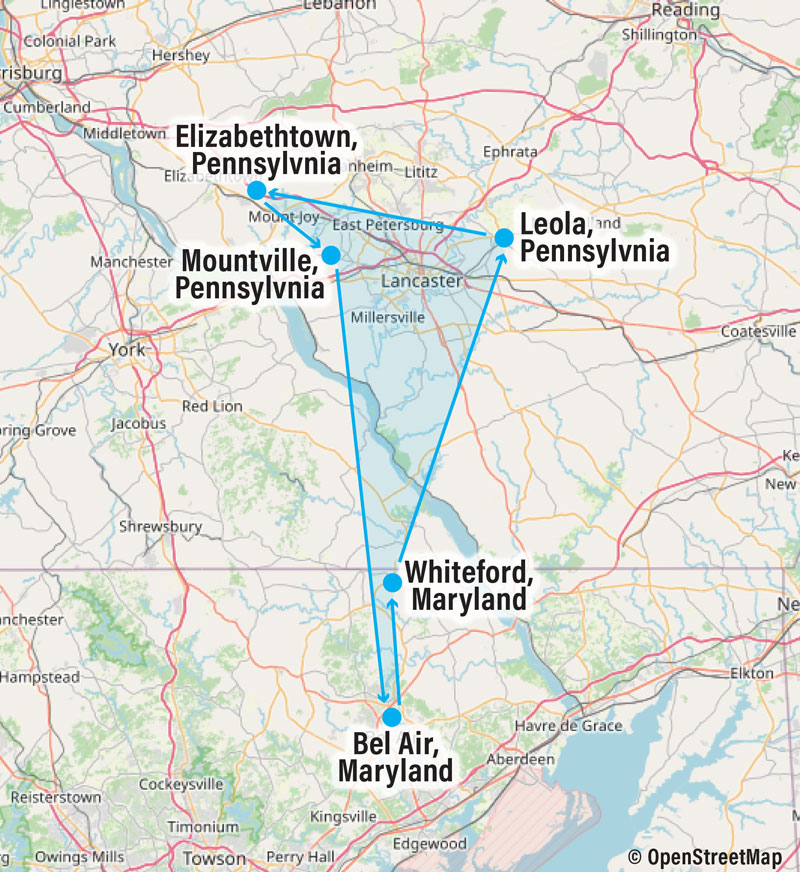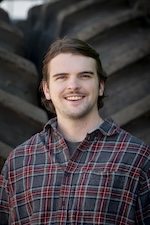
During my trip, I stayed at my childhood home in Baltimore and traveled to various locations throughout Maryland, Pennsylvania and Delaware. From Baltimore to Jay Baxter's farm in Georgetown, Del., I drove roughly 140 miles. From Baltimore to the New Holland Headquarters, I drove roughly 100 miles and from Baltimore to Steve Groff's farm in Holtwood, Penn., I drove about 50 miles. The blue triangle on the map represents the 245-mile radius that I traveled during my day-in-the-life of a shortline manufacturer salesman visit. Graphic Created by Lewis Horn. Source: ©OpenStreetMap
As a proud native of Baltimore, Md., who has now lived in Milwaukee, Wis., for 7 years and counting, I typically only get a chance to head back to the East Coast for Christmas and occasionally Thanksgiving. But in early June I had the chance to visit some of my family and friends while also going on a few work-related visits throughout Maryland, Delaware and Pennsylvania. This gave me the unique opportunity to learn more about the rich agricultural history in and around the area where I grew up.
Georgetown, Delaware
My first stop was no-tiller Jay Baxter’s farm in Georgetown, Del., less than 20 miles from Rehoboth Beach where I got to spend many summers on vacation with my family as a teenager.
Immediately upon arriving at Baxter’s farm, I could tell we were not far from the Atlantic Ocean — the air just has a certain feel to it. And Baxter showed me just how sandy his soils are because of their close proximity to the beach. As Baxter described it, “our soils go from sand, to sandy sand.”
He says they spend a lot of time and effort trying to build their soil up but it is not an easy task. Cover crops and no-till have been the focus on their farm for multiple decades now and Baxter regularly experiments with new ideas revolving around regenerative agriculture.
He also says their close proximity to the Chesapeake Bay means that he and other farmers in the area are held to a very high standard in terms of water quality. They have to be extremely diligent about preventing erosion — something he foresees being a stricter requirement for nearly every farmer in the country in the not so distant future.
Check out this podcast episode with Jay Baxter for a more in-depth look at what he’s doing on his farm and what it takes to manage a farm in Georgetown, Del.
New Holland, Pennsylvania
A few days after visiting Jay Baxter, I stopped by the New Holland Manufacturing Plant & Headquarters in Lancaster County, Penn., to get a tour of the facility and learn about the rich agricultural history in that part of the state. Plant manager Ryan Alleman took me on an extensive tour and helped me understand just how much detail goes into each and every step of the manufacturing process for everything New Holland produces. I also got to chat with him one-on-one after the tour was over and learn more about his day-to-day responsibilities.
This facility serves not only as the North American headquarters of the New Holland Agriculture and New Holland Construction brands but also as a global “Center of Excellence for Hay and Forage” products with dedicated R&D. New Holland agricultural equipment including round balers, small square balers, pull-type forage harvesters, harvester heads, disc mowers, rakes and spreaders are manufactured on site.
The first room I got to see was the gift shop which features a wall-to-wall timeline of events starting with the very beginning of New Holland’s history that dates back to 1895 when Abe Zimmerman established New Holland Machine Company as an equipment repair company to serve Lancaster County farmers. The first facility was run out of a horse barn on North Railroad Ave. in New Holland, Penn. The timeline covers three walls in the gift shop and eventually spans all the way into present day. New Holland continues to add to their rich ag history each year.
Bel Air, Maryland & Lancaster, Pennsylvania
My next adventure started out in Bel Air, Maryland where I met up with Whitney Case, a sales associate for Cummings & Bricker who travels around parts of the East Coast selling ag implements and equipment to local dealerships.
I spent nearly 12 hours with Whitney in order to get a full look into a day-in-the-life of a shortline salesman. We stopped at 4 dealerships including Atlantic Tractor in Whiteford, Md., Agriteer in Leola, Penn., Ag-Com in Elizabethtown, Penn., and Ebling’s in Mountville, Penn. We drove nearly 250 miles total throughout the day.

Approximate Mileage Breakdown:
Baltimore to Bel Air: 40 miles.
Bel Air to Whiteford: 20 miles.
Whiteford to Leola: 50 miles.
Leola to Elizabethtown: 25 miles.
Elizabethtown to Mountville: 20 miles.
Mountville to Bel Air: 50 miles.
Bel Air to Baltimore: 40 miles.
Total: 245 miles.
Graphic Created by Lewis Horn. Source: ©OpenStreetMap
The biggest takeaway from this part of the trip was that people like Whitney Case are on the clock 24/7 and will stop at nothing to make sure their customers are satisfied. He is constantly on the road — he even referred to his truck as his office. Whitney’s work ethic was admirable and definitely gave me something to think about in terms of my own job.
For a more detailed account of my day-in-the-life as a shortline manufacturer salesman, be sure to check out the upcoming Shortline Legends edition of Farm Equipment Magazine, coming to you in late August or early September.
Holtwood, Pennsylvania
The last stop on my trip was to No-Till Legend and cover crop expert Steve Groff’s farm in Holtwood, Penn. Groff told me how he first got the idea to build the first roller crimper on U.S. soil because of a few memorable presentations he heard at the 1995 National No-Tillage Conference.
His son, David also gave me a walkthrough of nearly all the equipment they use on their farm and why each piece is so crucial to their operation. Steve also gave me the lowdown on what it takes to grow hemp in a no-till system as well as his strategies for utilizing cover crops on his farm and details on growing his own cover crop seeds.
The entire trip was a great experience to learn more about the history of agriculture and what it looks like in the surrounding area close to where I grew up. One thing rang true to me about people in the world of agriculture regardless of their specific role or location — this industry is full of hard workers and go-getters and most of all — people who are excited and willing to teach you and help you learn about the wonders of agriculture in the U.S.
Related Content:
[Podcast] Cover Crop Mixes, Seeding Methods & Farm History with Jay Baxter
[Video] No-Tillage Conference Sparked Idea for Steve Groff's Roller Crimper






